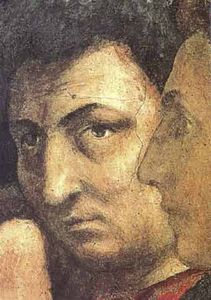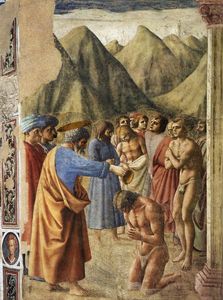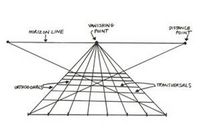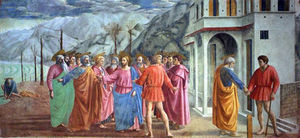Tommaso Cassai Masaccio Style and Technique
- Full Name:
- Tommaso Cassai
- Short Name:
- Masaccio
- Alternative Names:
- Masaccio, Moso
- Date of Birth:
- 21 Dec 1401
- Date of Death:
- 1427
- Focus:
- Paintings
- Mediums:
- Tempera, Other
- Subjects:
- Figure
- Art Movement:
- Renaissance
- Hometown:
- San Giovanni Valdarno, Italy
- Living In:
- Florence, Italy
- Tommaso Cassai Masaccio Style and Technique Page's Content
- Introduction
- Style
- Method
Introduction
Masaccio, also known as the 'Father of the Renaissance' endured a career of only seven years but in that time he built the foundation of what would become one of the greatest art movements. His techniques and developments in spatial perspective would become a standard and would set the bar for Renaissance painters succeeding him.
It is said that Masaccio's painting Trinity is the first accurate portrayal of perspective in Western Art and his use of humanism in the Brancacci Chapel became a school for aspiring artists.
Tommaso Cassai Masaccio Style
By breaking away from Gothic traditions, reverting back to Classicalism and employing new techniques in perspective, Masaccio created a style that shaped the development of the Florentine Renaissance. He was thought to have studied under the architect Brunelleschi and possibly the sculptor Donatello, mimicking their uses of structure and light in painting.
Most prominent in Masaccio's works are his ability and use of pictorial space, three-dimensional objects, vanishing-points, development of light and shadow and portrayals of characters that exist in real time and real space.
Linear perspective:
From the architect, painter and writer Leon Battista Alberti's book 'Della Pittura' ('On Painting) the basic guidelines and rules of linear perspective are derived. Without Masaccio's invention or incorporation of Brunelleschi's perspective achievements in painting, Alberti's guidelines would have seemed hypothetical if they would have existed at all.
To achieve linear perspective, adding depth and a three-dimension to the painting, one must draw a horizon line to connect the viewer's eye to a vanishing-point line - like where the sky meets the ground. Horizontal lines called orthogonal lines are then drawn over the canvas or work space. The point where orthogonal lines meet is called the vanishing point. One can compare this to train tracks in the distance.
The use of the vanishing-point not only allows artists to produce three-dimensional objects but also to control the viewer's eye and enhance the theme, as we see in Tribute Money, at Jesus' head.
Tommaso Cassai Masaccio Method
-

San Giovenale Triptych
-

Trinity - Perspective
Trinity - Vanishing-point
The vanishing-point is set at the viewer's eye level with a distance point outside of the painting. Having the vanishing-point low, that is lower than most the figures, balanced with the vertical axis of the vault, the illusion of the three-dimensional vault over Jesus and God is powerful.
-

Trinity - Vantage point
Early years - Masaccio's Development of linear perspective:
It is difficult to distinguish what paintings the artist produced in his early life. We know that he started to work with Masolino around the age of 21 but was probably painting professionally in Florence before that time.
It is possible that the painting San Giovenale Triptych could be attributed to Masaccio and it definitely shows a young painter beginning to explore in his technique of linear perspective. The Giovenale Triptych depicts the Virgin and Child but lacks control over the use of light and the vanishing-point on the Virgin's chin. Spatial uses of the characters are present but the artist does not employ the use of the linear perspective technique of later works.
Later years - Linear Perspective and Humanism:
With Masolino, Masaccio traveled to Rome between the ages of 21 and 23 and was said to have dropped the Gothic style and saved traditions from Giotti, by dropping drastic shifts in color for a more naturalistic approach that employed neutral colors, aligning his depictions with humanism instead of symbolic.
In Rome he supposedly undertook a series of frescoes, probably three, at Saint Clemente before the frescoes in the Brancacci Chapel but it is unclear if he did them himself or sketched the frescoes and left them for other painters to finish. All of these frescoes are now lost.
Masolino had begun working on the Brancacci Chapel two or three years before Masaccio did and it is still difficult to determine which frescoes were painted by Masaccio and not Masolino.
In the Brancacci Chapel we see the combination of perspective mixed with humanism in the depictions of characters. The portrayals of the figures in Tribute Money have the presence of life-like figures. The amount of detail and softness of lines with the use of a single light source and vanishing-point across Jesus' head distinctly makes this painting a work of the Renaissance. The wavering drapery of their clothing and the amount of detail of light in the painting is distinctly Masaccio.
In the painting Trinity, although not known for its humanism qualities, the use of linear perspective is heightened and clearly stands as one of the very first examples of spatially-correct art in the Western world. The vault above the vanishing-point is both haunting and looming.








